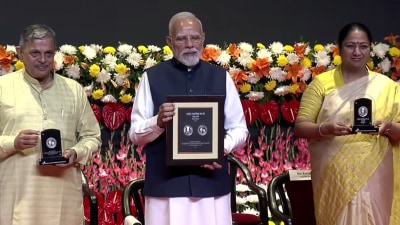The making of Navi Mumbai International Airport’s floating lotus: decoding the design, symbolism and engineering
Days before the inauguration of Navi Mumbai International Airport, The Indian Express got a glimpse into its design, and how London-based Zaha Hadid Architects reimagined the national flower in steel and glass.
 The result is a “floating lotus” terminal that blends functionality with art, borrowing cues from India’s traditional architecture. (Express Photo)
The result is a “floating lotus” terminal that blends functionality with art, borrowing cues from India’s traditional architecture. (Express Photo)Ahead of its much-awaited inauguration by Prime Minister Narendra Modi on October 8, the Navi Mumbai International Airport (NMIA) received its Aerodrome Licence, which is essential for commencing operations, from the Directorate General of Civil Aviation (DGCA) on Tuesday. While much attention has been on the airport’s capacity — with two parallel runways designed to eventually handle up to 90 million passengers a year — the NMIA is also being projected as an architectural landmark.
Ahead of the inauguration, The Indian Express got a peek into the design, and how London-based Zaha Hadid Architects (ZHA) reimagined India’s national flower in steel and glass. The result is a “floating lotus” terminal that blends functionality with art, borrowing cues from India’s traditional architecture.
A lotus beyond ornament
For ZHA, known for their organic, futuristic designs, the lotus was not just a decorative motif but the basis of the terminal’s structure. Its layered unfolding informed the design of sculptural columns and roof canopies.
At the centre of the terminal are 12 sculptural columns shaped like unfurling petals. Hollowed to channel daylight, they are designed to draw natural light into the concourse and create shifting patterns through the day. Beyond their visual effect, “the columns guide passenger circulation, establishing rhythm and orientation in a way reminiscent of temple halls, where structural supports also carried symbolic meaning,” a spokesperson for the NMIA told The Indian Express.
Columns with meaning
The use of columns draws from a long architectural tradition in India, from the mandapas of temples to the rock-cut halls of Ajanta and Ellora in Maharashtra. At NMIA, 12 feature columns are shaped as petals in bloom, while 17 mega columns function as invisible roots. These mega columns support the weight of the roof canopy and are engineered to withstand seismic shocks, high winds and heavy loads, and are designed such that the roof canopy appears to ‘float’ above the terminal.
Together, the expressive feature columns and the structural mega columns form a dual system that blends symbolism with engineering.
“The lotus serves as both a motif and the structural and cultural foundation of the terminal. The 12 sculptural feature columns bring in natural light and guide passenger movement, while the 17 mega columns carry the weight of the soaring roof canopies, creating vast open spaces without obstruction. This balance of expressive design and robust engineering ensures the airport is both efficient and symbolic,” the spokesperson said.
Engineering the petals
The lotus-inspired roof also demanded unusual engineering. Its curved, layered petals could not be built with standard trusses, requiring custom moulds, modular prefabrication and millimetre-level precision. “Construction became a choreography of cranes, welds and reinforced concrete, each component lifted and placed with painstaking accuracy,” shared the spokesperson.
The petals serve practical functions beyond design. Their slopes are shaped to reduce wind resistance, their curves to channel monsoon rainwater, and skylights between them to distribute daylight across the concourse. According to the spokesperson, “Skylights between the petals act as apertures, while the hollowed feature columns diffuse and animate daylight. For passengers, the effect is transformative: moving through a concourse alive with shifting patterns, the space feels more ceremonial than industrial.”
In line with a growing global trend where airports are envisioned as more than transit spaces, the NMIA aims to be both poetic and memorable—while promising resilience and safety.







